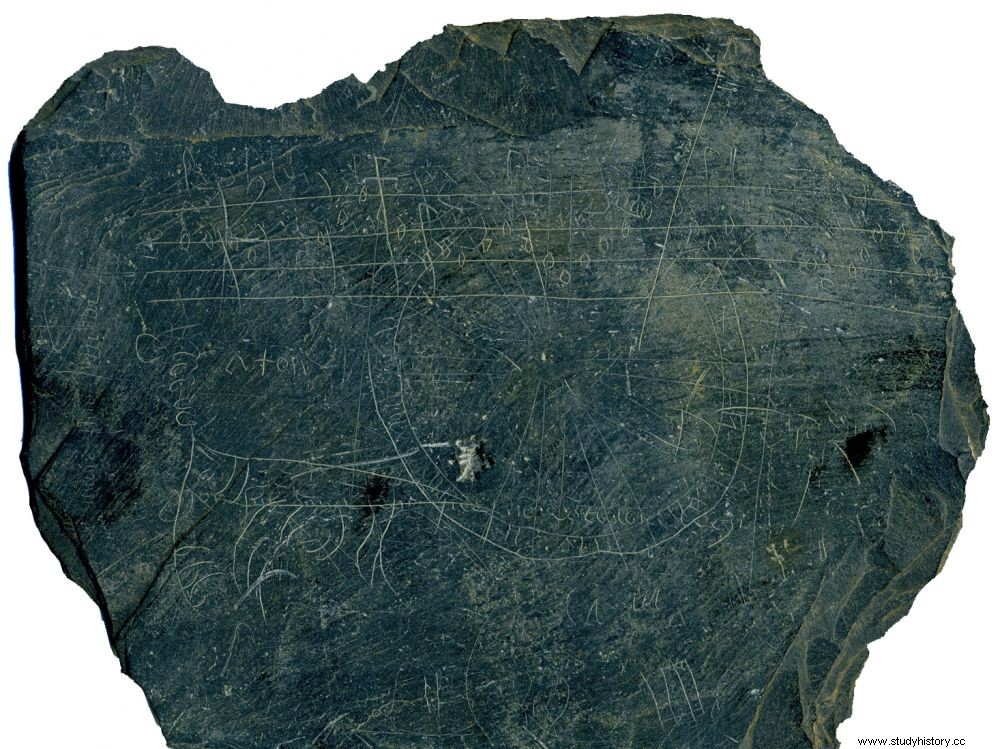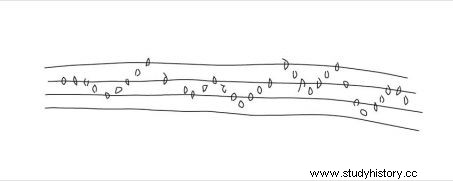Archaeologists have brought a 15 th melody back to life century found on a shale slab unearthed during excavations at the Jacobins convent in Rennes. Soprano Dominique Fontaine explains how.

Schist plaque featuring a musical score from the 15th th century, discovered during archaeological excavations at the convent of the Jacobins, in Rennes.
The small engraved medieval "slate" barely 20 cm wide appeared during excavations in the embankments of the Jacobins convent in Rennes. "It was on the site of the large refectory, dated from the 15th th century, recalls Gaetan Le Cloirec, archaeologist at the National Institute for Preventive Archaeological Research (INRAP) who led this imposing project from 2011 to 2013. It was not the first one we found. Some presented sketches of hopscotch, others drawings of boats. But this one struck us as very special: en studying these graffiti closely, we saw that this slate slab had… a musical score! »
"It was through the voice that the prayer was spoken"
Four lines made of diamond-shaped notes (see box) that will identify a 15th century chant century, which unlike the current music theory, was not transcribed on five lines. A decryption carried out thanks to Dominique Fontaine, soprano of the musical ensemble Ad Lib , in Rennes, one of the few psalmists (the equivalent of a chapel master) specializing in ancient religious music. “Maybe it was an essay in composition for a class or an original work , specifies the singer, contacted by Sciences et Avenir. Considering the melody to be complete, it is a so-called A aeolian score, a relatively late form in European religious music ". In the Middle Ages, religious songs were mainly composed in 4 modes:D, E, F and G. “For the record, this mode of A is currently very popular in traditional Celtic music… and more widely in Heavy metal , laughs the singer who continues:Rare are the instrumental works noted during these periods because it is by the voice that the prayer was expressed. It was thought, moreover, since St Gregory (Pope Gregory 1 st ) that it would be better heard by God by being sung everywhere and by everyone at specific times. Hence the Books of Hours to follow the offices of the day .
The singer has deciphered and performed this one-voice religious melody.

Transcription of the musical score on paper by Françoise Labaune-Jean, Inrap archaeologist.
"When I played this tune on the excavation site to the thirty or so archaeologists who were present, we all had a twinge in our hearts, admits Gaetan Le Cloirec. The past was suddenly embodied through that voice.” The song was also disclosed on March 15, 2017 during the official submission to the State services of the final report of the excavations of the Jacobins convent in Rennes. An exceptional project in which more than sixty researchers participated, and which delivered with Roman temples, ancient buildings and thousands of objects. More than 800 burials have also been unearthed, including lead coffins and reliquaries, as well as the astonishing remains of Louise de Quingo (1656) found in a spectacular state of preservation. Something to partially rewrite the history of the great Breton city... to a tune of music!
Two major exhibitions are planned at the Musée de Bretagne between 2018 and 2019.
About the shape of notes
In the Middle Ages, the sharpened nib made it possible to write notes that looked more like shorthand signs, before they were reproduced in a square format filled with ink. The template of the notes indicated the rhythm to follow. Later, to save ink, we no longer fill in the body of the notes. Then over time, the copyists begin to round them for the sake of efficiency. The musical printing press kept the lozenge notes until the beginning of the 17th
th
century.
